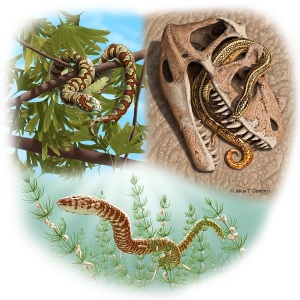
Paleo reconstructions of three Jurassic to Lower Cretaceous snakes: top left, Portugalophis lignites (Upper Jurassic) in a ginko tree, from the coal swamp deposits at Guimarota, Portugal; top right, Diablophis gilmorei (Upper Jurassic), hiding in a ceratosaur skull, from the Morrison Formation, Fruita, Colorado; bottom center, Parviraptor estesi (Upper Jurassic/Lower Cretaceous) swimming in freshwater lake with snails and algae, from the Purbeck Limestone, Swanage, England. (Credit: Julius Csotonyi)
Researchers have found the oldest known snake fossils ever discovered, pushing back the first record of snakes by 70 million years. The authors suggest that the fossils hint that the classic snake head evolved first and was then followed by the evolution of the elongated, limbless body.
Studying fossilized skull bones found in England, Portugal and the USA, authors identified four new species of snake dated to the Jurassic period, 143 to 167 million years ago. The new species share recognizable features with modern-day snakes, such as sharp, backward pointing teeth, but their overall shape, length and body form remains unknown.
Original research paper published in Nature Communications on January 27, 2015.
Names and affiliations of selected authors
